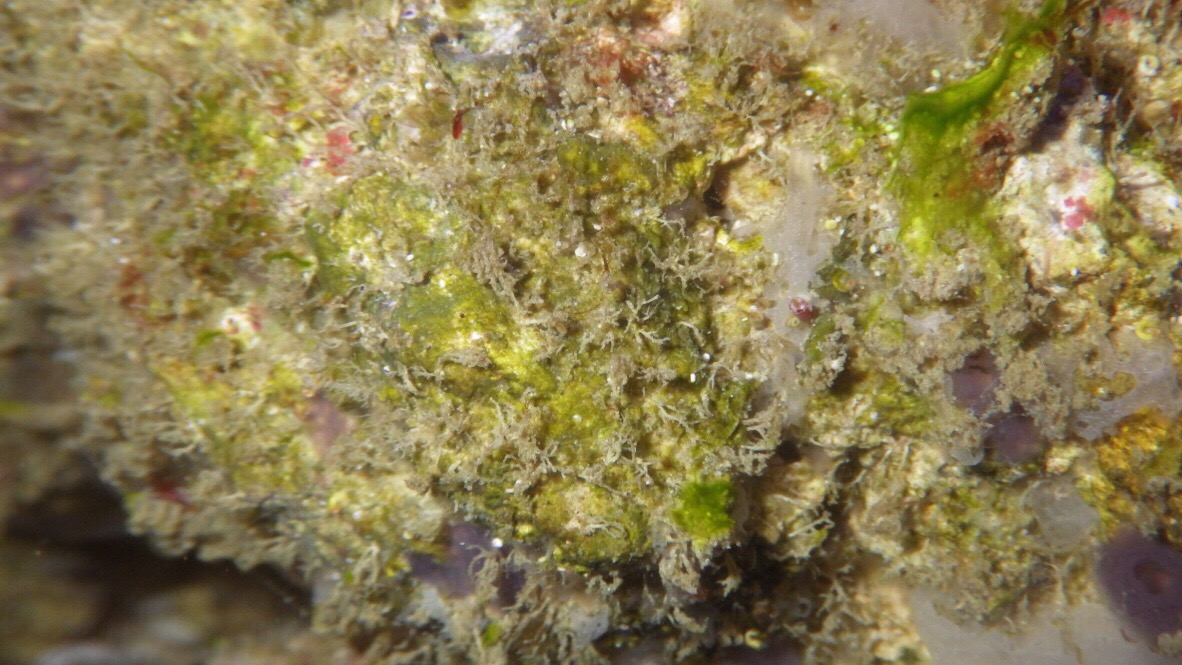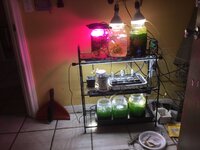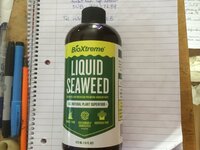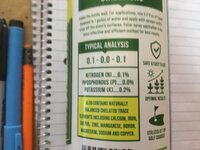In September of 1971, I entered the Texas Maritime Academy on Pelican Island next to the Galveston ship channel. It was educational/amusing to see the 18 year olds in the Cadet Core marching around campus. I had just discharged from 4 years active duty with four 90 day tours of duty in Cambodia. We did’t spit shine our boots in the jungles.
As a marine engineer student, the first technical elective I took that first semester was Chemical Oceanography 101 in which I was introduced to the concept of Dynamic Equilibrium where carbon dioxide in the atmosphere and calcium carbonate in limestone sediments acted to maintain alkalinity in our oceans. So with this limited knowledge, I decided to set up a 55G glass tank as a Galveston Bay theme. I used standard undergravel filter with crushed up oyster shells purchased from chicken feed store. I found a large oyster cluster in Galveston Bay with fan & tube worms for live rock center piece in tank. From the grass flats & marsh reeds, grass shrimp and green mollies were collected . Anemones from the jetties in Galveston completed stocking this 55G tank. All movement for filtration was provided by one air pump on uplift tubes. I dragged that tank around for 10 yrs. The last time I moved that tank in 1980, I showed off the tanks fish and commented about the beautiful dark burgundy carpet over the ugly crushed up oyster shell. A visitor looking at my tank asked me why I had the cynobacteria mat so thick everywhere. We have come a long way from that day.
As my fascination with the marine aquarium hobby continued and my career took me offshore into “Blue Water” as a subsea engineer whose department was underwater blowout preventers. Depending on locations in the world, work schedule was 14/14 or 28/28 on/off. So with a 150G reef tank in my new home, I plumbed a remote sump that grew into 1000G of algae refugiums and two propagation/growout troughs that were 4’ by 8’ by 12” high. With zero nutrient export, I feed heavy when home on days off but no food was added to tank when I was away. Even though I didn’t know all the details, I did know by cause & effect that my algae filter refugium was a two way street with recycling nutrients. This is the focus of the thread: Recycling Nutrients
I briefly described how CO2 as a gas can seek equilibrium with water to combine with alkalinity & photosynthesis to produce glucose which is carbon. So, let’s follow nitrogen as a gas, as it seeks solubility equilibrium to dissolve in water. Add bacteria, like Cynobacteria, to convert free nitrogen gas into available nitrogen in a process called “nitrogen fixation”.
[Nitrogen (N2) fixation is the microbially mediated conversion of relatively inert dinitrogen gas to biologically available ammonia. ... In the marine environment, N2 fixation occurs in numerous ecologically diverse nearshore, coastal and open-ocean environments.]
www.sciencedirect.com
Nitrogen fixation in the marine environment: relating genetic potential to nitrogenase activity
Nitrogen fixation can be an important source of nitrogen for biological productivity in the marine environment. Biological nitrogen fixation is cataly…
www.sciencedirect.com www.sciencedirect.com
Abstract
[Nitrogen fixation can be an important source of nitrogen for biological productivity in the marine environment. Biological nitrogen fixation is catalyzed by the enzyme nitrogenase, which is possessed by diverse microorganisms representing virtually all phylogenetic groups. Interest in nitrogen fixation in the sea has usually been focused on rates of nitrogen fixation, but information on the types of species present with the capability for nitrogen fixation can be important for predicting nitrogen fixation rates in situ. Molecular tools for detection and characterization of the nitrogenase (nif) genes and immunoassays for nitrogenase protein can provide new information on the factors regulating the distribution and activity of diverse nitrogen fixing organisms in the marine environment. Amplification and characterization of nifH sequences has made it possible to identify the type(s) of organism responsible for nitrogen fixation, such as in aggregates of the cyanobacterium Trichodesmium. Differences in nitrogen fixation patterns have been linked to genetic differences between Trichodesmium strains. Further development of these approaches will provide new and powerful ways to link the genetic potential for nitrogen fixation to nitrogen fixation rates in the ocean.]
Here we are in Dec 2020. I am not sure my methods have changed much since 1971. I just know more about why the method works.
I have been practicing the Trident Method for > 45yrs but without the skimmer.
As a marine engineer student, the first technical elective I took that first semester was Chemical Oceanography 101 in which I was introduced to the concept of Dynamic Equilibrium where carbon dioxide in the atmosphere and calcium carbonate in limestone sediments acted to maintain alkalinity in our oceans. So with this limited knowledge, I decided to set up a 55G glass tank as a Galveston Bay theme. I used standard undergravel filter with crushed up oyster shells purchased from chicken feed store. I found a large oyster cluster in Galveston Bay with fan & tube worms for live rock center piece in tank. From the grass flats & marsh reeds, grass shrimp and green mollies were collected . Anemones from the jetties in Galveston completed stocking this 55G tank. All movement for filtration was provided by one air pump on uplift tubes. I dragged that tank around for 10 yrs. The last time I moved that tank in 1980, I showed off the tanks fish and commented about the beautiful dark burgundy carpet over the ugly crushed up oyster shell. A visitor looking at my tank asked me why I had the cynobacteria mat so thick everywhere. We have come a long way from that day.
As my fascination with the marine aquarium hobby continued and my career took me offshore into “Blue Water” as a subsea engineer whose department was underwater blowout preventers. Depending on locations in the world, work schedule was 14/14 or 28/28 on/off. So with a 150G reef tank in my new home, I plumbed a remote sump that grew into 1000G of algae refugiums and two propagation/growout troughs that were 4’ by 8’ by 12” high. With zero nutrient export, I feed heavy when home on days off but no food was added to tank when I was away. Even though I didn’t know all the details, I did know by cause & effect that my algae filter refugium was a two way street with recycling nutrients. This is the focus of the thread: Recycling Nutrients
I briefly described how CO2 as a gas can seek equilibrium with water to combine with alkalinity & photosynthesis to produce glucose which is carbon. So, let’s follow nitrogen as a gas, as it seeks solubility equilibrium to dissolve in water. Add bacteria, like Cynobacteria, to convert free nitrogen gas into available nitrogen in a process called “nitrogen fixation”.
[Nitrogen (N2) fixation is the microbially mediated conversion of relatively inert dinitrogen gas to biologically available ammonia. ... In the marine environment, N2 fixation occurs in numerous ecologically diverse nearshore, coastal and open-ocean environments.]
www.sciencedirect.com
Nitrogen fixation in the marine environment: relating genetic potential to nitrogenase activity
Nitrogen fixation can be an important source of nitrogen for biological productivity in the marine environment. Biological nitrogen fixation is cataly…
www.sciencedirect.com www.sciencedirect.com
Abstract
[Nitrogen fixation can be an important source of nitrogen for biological productivity in the marine environment. Biological nitrogen fixation is catalyzed by the enzyme nitrogenase, which is possessed by diverse microorganisms representing virtually all phylogenetic groups. Interest in nitrogen fixation in the sea has usually been focused on rates of nitrogen fixation, but information on the types of species present with the capability for nitrogen fixation can be important for predicting nitrogen fixation rates in situ. Molecular tools for detection and characterization of the nitrogenase (nif) genes and immunoassays for nitrogenase protein can provide new information on the factors regulating the distribution and activity of diverse nitrogen fixing organisms in the marine environment. Amplification and characterization of nifH sequences has made it possible to identify the type(s) of organism responsible for nitrogen fixation, such as in aggregates of the cyanobacterium Trichodesmium. Differences in nitrogen fixation patterns have been linked to genetic differences between Trichodesmium strains. Further development of these approaches will provide new and powerful ways to link the genetic potential for nitrogen fixation to nitrogen fixation rates in the ocean.]
Here we are in Dec 2020. I am not sure my methods have changed much since 1971. I just know more about why the method works.
I have been practicing the Trident Method for > 45yrs but without the skimmer.


















